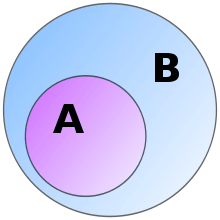Inclusion map

In mathematics, if is a subset of , then the inclusion map (also inclusion function, insertion,[1] or canonical injection) is the function that sends each element, , of to , treated as an element of :
A "hooked arrow" ( U+21AA ↪ RIGHTWARDS ARROW WITH HOOK)[2] is sometimes used in place of the function arrow above to denote an inclusion map; thus: (On the other hand, this notation is sometimes reserved for embeddings.)
This and other analogous injective functions[3] from substructures are sometimes called natural injections.
Given any morphism f between objects X and Y, if there is an inclusion map into the domain , then one can form the restriction fi of f. In many instances, one can also construct a canonical inclusion into the codomain R→Y known as the range of f.
Applications of inclusion maps
Inclusion maps tend to be homomorphisms of algebraic structures; thus, such inclusion maps are embeddings. More precisely, given a sub-structure closed under some operations, the inclusion map will be an embedding for tautological reasons. For example, for a binary operation , to require that
is simply to say that is consistently computed in the sub-structure and the large structure. The case of a unary operation is similar; but one should also look at nullary operations, which pick out a constant element. Here the point is that closure means such constants must already be given in the substructure.
Inclusion maps are seen in algebraic topology where if A is a strong deformation retract of X, the inclusion map yields an isomorphism between all homotopy groups (i.e. is a homotopy equivalence).
Inclusion maps in geometry come in different kinds: for example embeddings of submanifolds. Contravariant objects[4] such as differential forms restrict to submanifolds, giving a mapping in the other direction. Another example, more sophisticated, is that of affine schemes, for which the inclusions
and
may be different morphisms, where R is a commutative ring and I an ideal.
See also
Notes
- ↑ Mac Lane, S.; Birkhoff, G. (1967), Algebra , page 5, says "Note that “insertion” is a function and "inclusion" a relation ; every inclusion relation gives rise to an insertion function."
- ↑ "Arrows – Unicode" (PDF). Retrieved 2017-02-07.
- ↑ Chevalley, C. (1956), Fundamental Concepts of Algebra , p. 1.
- ↑ I.e., objects that have pullbacks; these are called covariant in an older and unrelated terminology
References
External links
